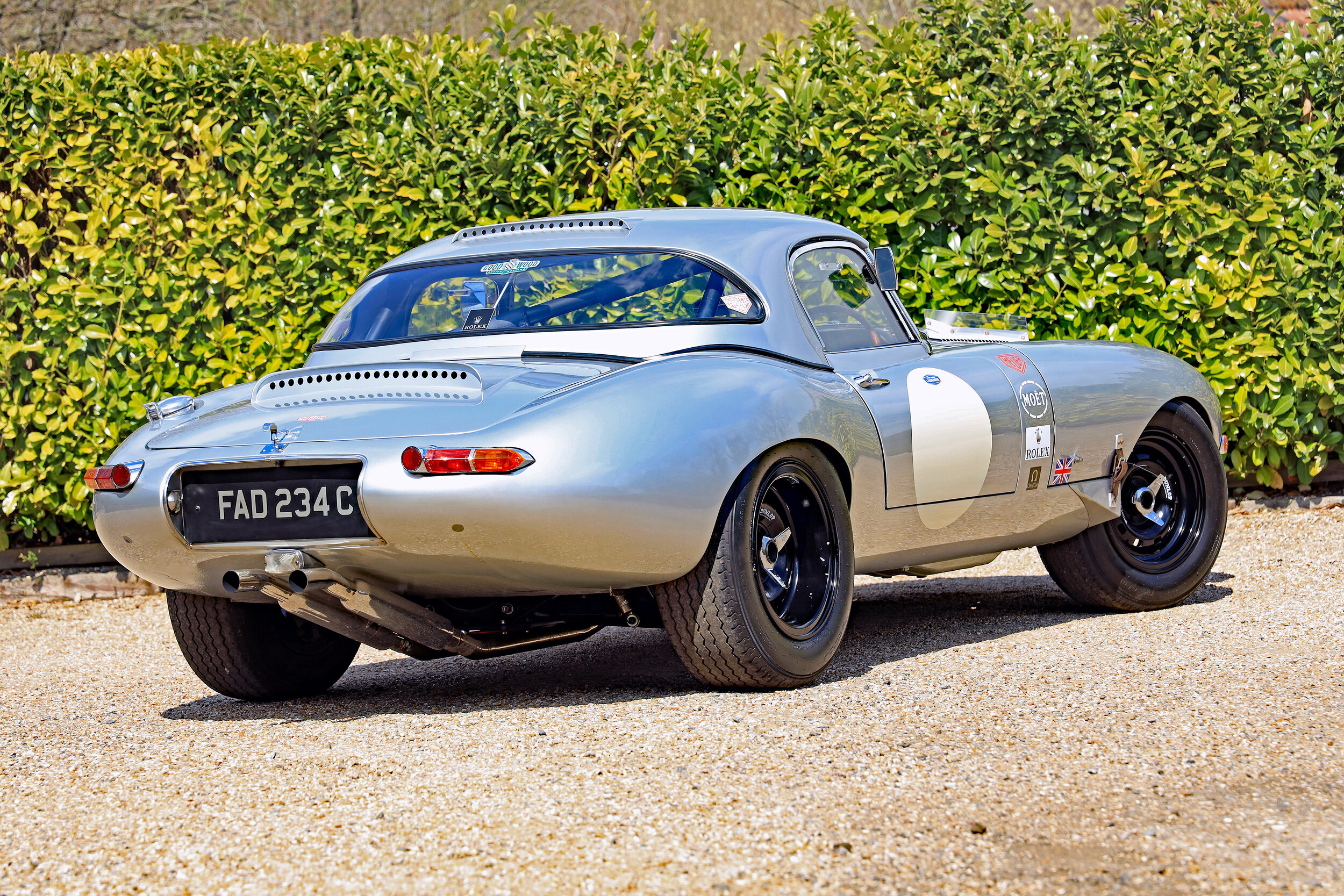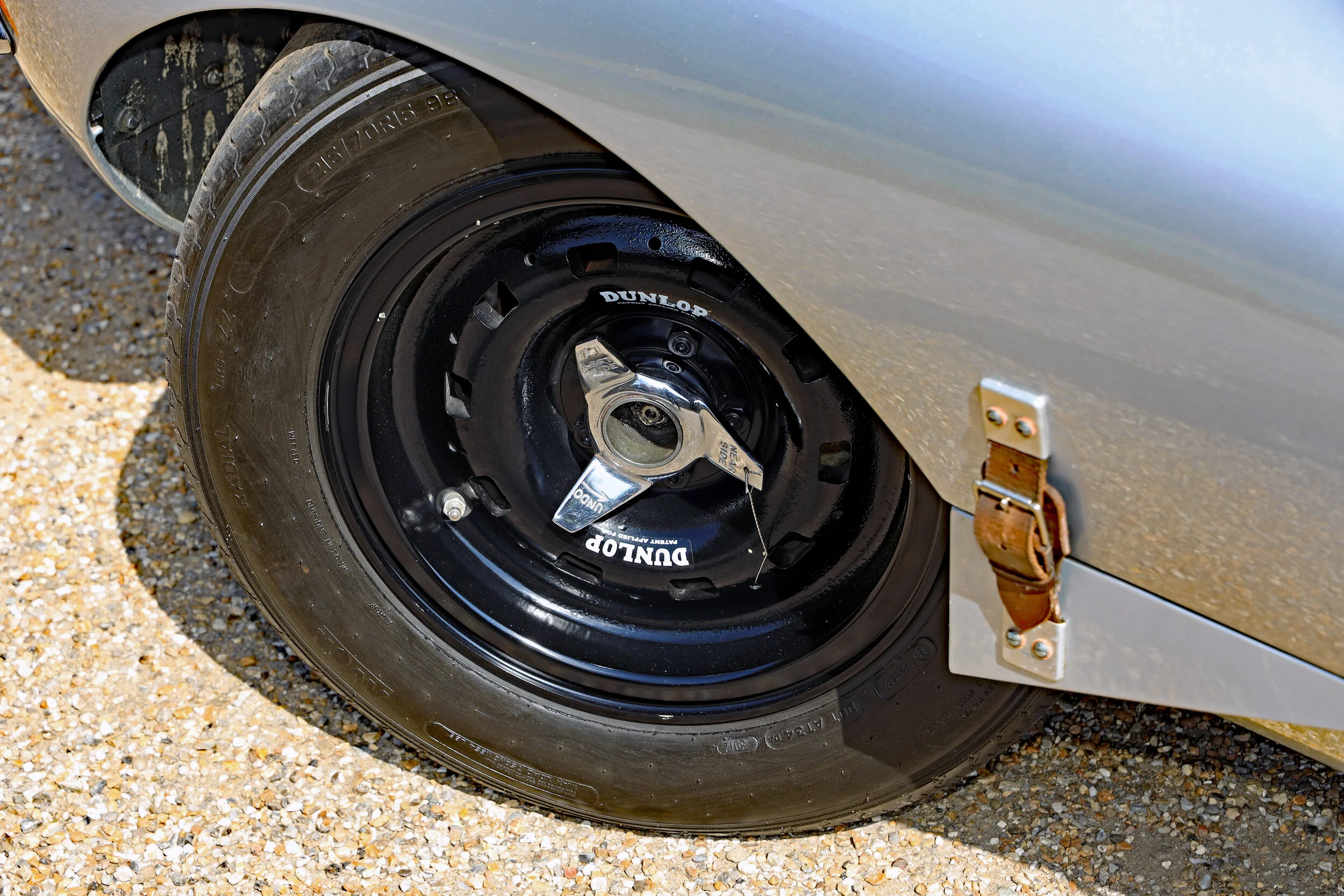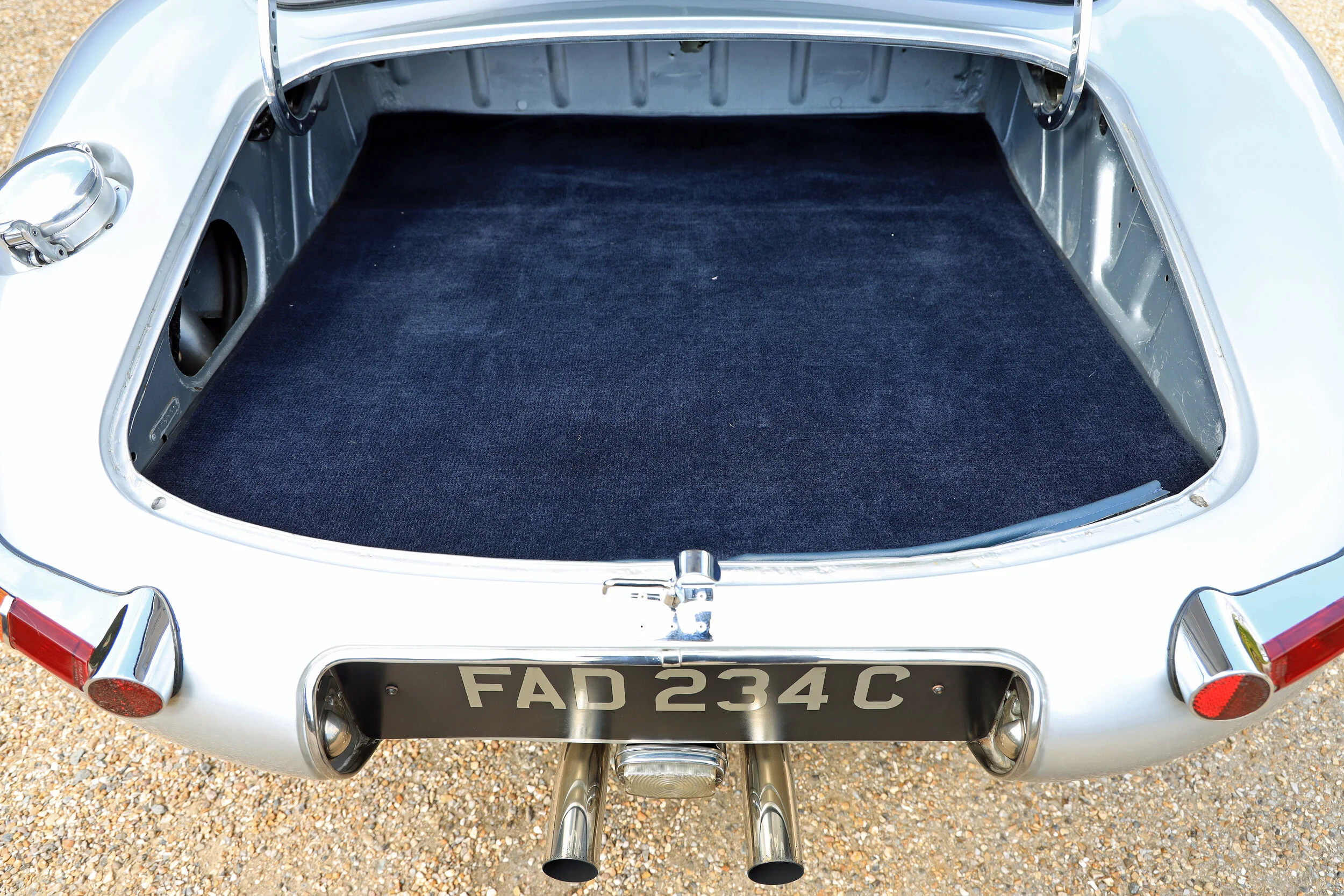1965 Jaguar E-type Semi-Lightweight ‘Evocation’
PRICE £ SOLD
YEAR 1965
ENGINE 4235c/6-cyl/DOHC/Triple Weber 45DCOE carburettors
POWER 344bhp@6500rpm (est)
TORQUE 314lb ft@4750rpm (est)
MAXIMUM SPEED 168mph (est)
0-60MPH 4.1sec (est)
GEARBOX RWD, five-speed manual
MILEAGE 6610 miles
MOT 12 months from sale
CHASSIS NUMBER IE 20883
ENGINE NUMBER 7E5302-9
COLOUR Audi Aluminium Silver
INTERIOR Blue Leather
WIDTH 1657mm
LENGTH 4450mm
BACKGROUND
All Jaguar E-types are special. But some are just that little bit more special than others. Although intended much more as a road machine than a racing machine, unlike its similarly-titled C- and D-type predecessors, it was inevitable that people would take E-types onto the race tracks of the world, right from the get-go. It was, after all, a very fast, very effective Jaguar capable of 150mph; performance which, at the time, was impressive in any car, let alone a road-going one.
However, for some (including Jaguar itself), that wasn’t quite enough. In 1962, the company created the Low Drag Coupe, as a pure racing machine intended to fight Ferrari’s new 250 GTO. The brainchild of Jaguar’s ace aerodynamicist Malcolm Sayer, the LDC retained the basic tub and much of the frame of the E-type, but used lightweight aluminium panels, a steeper windscreen, additional cooling ducts and perspex windows (aside from the windscreen).
Ultimately, the LDC proved not much more than a test-bed for Jaguar’s ideas, but it did lead onto the Lightweight E-types of 1963 to 1964. These also used aluminium panels and components, but were open top machines - although, in reality, most of them competed with hard-tops in place. Tuned engines provided considerably more power than the standard ones, thanks to triple Weber carburettors or Lucas mechanical fuel injection systems. They proved quite effective in shorter races, but ultimately lacked the outright endurance for longer races such as Le Mans and Sebring. However, with just 12 cars and two spare bodies made, they soon became legendary, ultra-desirable machines, so much so that in 2014, Jaguar revisited the theme and started building the six ‘missing’ Lightweights it had intended to put together in the 1960s. Even priced at over £1million each, these new ‘continuations’ still represented a bargain compared to the originals; when the seventh Lightweight produced (5114 WK) was auctioned in the USA in 2017, it made the equivalent of £5,768,050. See, special. Very, very special…
OUR CAR
Of course, if you don’t have a few spare million hanging around, there are much more reasonably-priced ways into Lightweight E-type ownership. Such as our car here, for example. There have been various Lightweight replicas - or Evocations - built over the years, and they continue to be constructed by specialists to this day. One of those that came up with its own, but very faithful interpretation of the iconic Lightweight was Zealia Engineering, a firm started by Safety Devices founder Brian Wilkinson. While the ones it constructed prior to Wilkinson’s death in 2014 were more correctly Semi-Lightweights, as they retained regular Series I chassis rather than modifying them with special parts as Jaguar’s had done (but this is largely true of all such recreations), they were otherwise very close to the real thing, with their outer panelling in aluminium.
This car has benefited from not only having Wilkinson work his magic on it but also involved several other top league specialists as well - thus making it a cut above many other Evocations. The car started life in August 1965 as a 4.2-litre Series I but by 2011, it was in poor condition. Bought by an enthusiast with the intention of creating his own vision of a Lightweight, it was comprehensively rebuilt by Wilkinson. After he’d completed the shell, it was fitted with aluminium bonnet, hard-top, doors and bootlid, and then finished and painted by Pitt Lane Restorations, in eye-catching Audi Aluminium Silver. The engine was redone by XK expert VSE including upgrades such as a Series III XJ6 big-valve head, Rob Beere RBC4 camshafts, high-spec oil pump, high-torque starter motor, alternator, and a lightened and balanced bottom end. Naturally triple Webers replaced the standard SU set-up. The factory-fitted four-speed gearbox went as well, in favour of an XJ-S five-speed unit.
Inside, the cabin was trimmed in period racing style, with blue leather aluminium bucket seats, four-point harnesses and exposed fuses and circuit breakers. Perspex windows were fitted, and the suspension and brakes were uprated as well; in the case of the latter, XJ-S items were adopted. The complete range of modifications, inside, outside and underneath, is very extensive but it is all detailed in paperwork, along with pictures of the restoration. Also included in the history file are photos of the restoration (in physical and CD form), bills (including a full service in March of this year, costing £562.23) and copies of magazine and internet features including the car. There’s also the Jaguar Heritage certificate, although this car is now very different to how it left Coventry in the summer of ‘65.
How good a job has been done was proved by this Jaguar winning Best in Class at the Warren Concours in 2016, and being invited for display at the Hampton Court Concours the following year. It’s done several other prestigious events since. However, a decade on from its rebuild, its use has been very sparing, with just over 6600 miles covered since restoration. Its previous owners must have had remarkable restraint, for this is the sort of Jaguar you just want to point at the horizon and drive until you run out of road…
BODYWORK
With so few miles covered since restoration, the bodywork on this car remains almost as good as when it was finished. The passing of 10 years seems to have scarcely affected it at all. There are a few stonechips, including a spot on the bonnet that has been touched up, but aside from that, it’s all in excellent condition. There’s no hint of corrosion, either on the steel or the aluminium, and no electrolytic reaction where the two metals meet. The paint finish is consistent throughout.
Among the more distinctive features, some of which are Lightweight-specific, are vents on the roof and bootlid, leather bonnet straps, a bonnet-mounted air deflector, Dunford-supplied wheels with three-eared spinners, externally-secured bootlid and a lockable Aston Martin fuel filler on the left-hand rear wing.
The underneath of the car has been left in body colour rather than undersealed, and is almost as immaculate as what’s on top. You can easily understand why this was a concours winner. The exhaust system is a bespoke creation, and has no issues - it almost looks as if it could have just been fitted yesterday.
Tyres are Avon CR6-22 radials, with 215/70 R15 items at the front and thicker 255/65 R15 ones at the rear, to cope with all that power being laid down. The fronts are dated 2012, the rears 2020, but all of them have no damage and plenty of tread left. The glossy black-painted wheels have the odd mark, but are overall in very good order and have Dunlop ‘Patent Applied For’ branding applied - a reference to the partnership between Jaguar and Dunlop to develop the braking technology.
INTERIOR
With the emphasis on a racing-focused cockpit, there are few creature comforts inside the E-type. Any passenger gets a collection of circuit breakers to look at, while there are battery and fan switches set into an alloy panel on the widened transmission tunnel. Fuel delivery can be cut off by the long toggle switch on the dash.
The seats are bucket items finished in blue leather and set in aluminium frames. They look like they’ve barely been sat in, as there’s only very minimal creasing. The carpets, door cards, floor mats and four-point harnesses are all finished in blue, and in very good nick although, inevitably, the driver’s matt does show some signs of shoe abuse. All the gauges work as they should and display healthy readings. While the speedometer looks like the standard 1960s’ item, its odometer is digital.
The shallow boot is carpeted to match the cabin, and is similarly very clean and tidy.
ENGINE AND RUNNING GEAR
Tip forward the huge bonnet, and it’s difficult to believe that what lies beneath is a working environment. There so much polished chrome and aluminium that it’s more like an industrial art installation than an engine.The three Weber carburettors, with their twin mesh intakes, dominate the bay, but everything surrounding them is very neat and clean, with nothing out of place or looking amateurish There are no signs of any leaks - and that’s quite something for any XK engine - and all the pipework and wiring are sound. Thanks to the recent service, the fluids are at the right levels and all healthy.
The car drives superbly. While it’s not exactly in its element just pottering around at slow speeds, it’s content enough to do so. But it’s when you open it up that it comes into its own. The XK engine through its custom-made exhaust sounds absolutely fantastic, and there’s a considerable amount of power on tap to enjoy - while the actual bhp and torque figures aren’t known, they’re probably in the region of 344bhp and 314lb ft that the originals boasted, if not in excess of that due to all the tweaks. The result is a car that, even by modern standards, is phenomenally fast, dynamic and dramatic, yet also handles and stops effectively due to its suspension and brake upgrades.
SUMMARY
This is a loving and very faithful homage to the Jaguar E-type Lightweight. It’s correct in so many details, and although a previous Concours winner, it’s no mere trailer queen - it has all the performance and handling to match its very handsome looks, and then some. Genuine Lightweights cost millions. This one doesn’t. It’s significantly cheaper than the real thing, yet offers much of the same authenticity and experience. There’s no mistaking the craftsmanship and skill that went into its creation. And, what is more, you can properly enjoy this on the road and on the track too, without feeling that you’re in something too priceless. It’s a millionaire’s machine that you don’t have to be a millionaire to buy.
Whilst Greenside Cars Ltd has tried to ensure information and assessments are accurate and complete, we are aware that some errors and omissions may occur from time to time. We are not able, therefore, to guarantee the accuracy of information and cannot accept liability for loss or damage arising from it. We highly recommend that you examine any vehicle to check the reliability of the information supplied. Please contact us for further details, images, or to arrange a viewing of this Jaguar E-type Semi-Lightweight.



















































